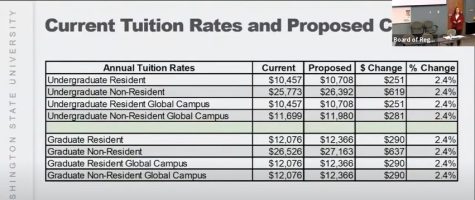WSU leaning more on state for funding
University relying less on tuition than past years, contrary to current budget trends
April 17, 2018
WSU is depending on the state government for a larger proportion of its revenue due to cuts to the price of tuition and increased spending on instruction at the new College of Medicine.
The university relied on the state government for 17 percent of its revenue in 2015 and 20 percent in 2017, according to WSU’s 2017 annual financial report. Reliance on tuition and fees as a source of revenue has dropped from 28 percent in 2015 to 24 percent in 2017.
The increase in dependence on the state for revenue has a direct relationship to the decrease in revenue from tuition and fees, Matthew Skinner, associate vice president of finance, said.
Skinner said money from the state in the form of operating appropriations supports the core of what WSU faculty and students do. Student fees, including components such as Services and Activities fees, can only be used depending on how the S&A committee allocates funds, Skinner said.
Skinner said resident undergraduate tuition for fiscal year 2016 dropped 5 percent, which led to the state increasing the operating appropriations to backfill the decline in tuition. In addition, a 10 percent reduction also occurred the following fiscal year, which prompted the state to increase the state operating appropriations once more, Skinner said. The decrease in resident undergraduate tuition took the burden off of students, he said.
“After they had increased tuition for years,” Skinner said, “[the Legislature] decided to buy that down.”
WSU’s decreased reliance on tuition and fees goes against national trends, according to a study by the State Higher Education Executive Officers Association, an organization that studies state and federal involvement in postsecondary education. Nationally, universities depended on tuition for about 36 percent of revenue in 2008 and about 46 percent in 2017, according to the study.
The decrease in resident undergraduate tuition is an attempt to reduce the cost of attendance not only for WSU, but all four-year universities in the state, Skinner said.
Christopher Mulick, WSU’s director of state relations, said the Legislature has had four different tuition policies over the last 12 years. The lesser-known part of the tuition bill, he said, is a tuition cap which prevents tuition from exceeding median wage growth in any given year. Since then, attention shifted toward funding the State Need Grant, Mulick said, which is money provided by the state to help low-income students pursue a degree.
“In a lot of ways we’re already providing free tuition for the neediest students through the State Need Grant,” Mulick said.
As the state gives the university more money, WSU is spending more on instruction. One such place is at the Elson S. Floyd College of Medicine in Spokane, Skinner said.
He said operating expenditures for research remained fairly consistent from year to year with slight variations. The federal research grants are competitive, he said.
“There’s fewer federal research dollars counting out for universities to bid,” Skinner said. “More and more universities are trying to get those dollars.”
Skinner said one of the components in President Kirk Schulz’ “Drive to 25” is to continue the growth in research activities.
According to the financial report, WSU’s proportional spending on research has decreased 2 percent since 2016. Mulick said more dramatic increases in spending in other areas, like instruction, may account for that change. A quarter of the university’s total spending was on instruction in 2015. That number jumped to 29 percent by 2017.




















